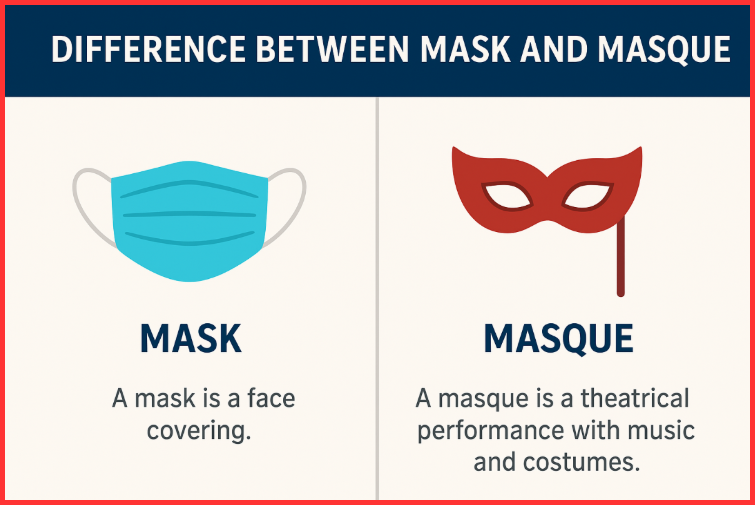The Difference Between Mask and Masque is that a mask is a physical covering worn on the face for protection, disguise, performance, or celebration, while a masque is a theatrical performance or drama that often involves masked performers, music, and dance.
In simple words:
Mask = The object you wear
Masque = A dramatic performance involving costumes and masks
Meaning of Mask
A mask is an object worn on the face to hide identity, protect the face, or represent a character. Masks are commonly used in:
- Medical protection (e.g., surgical masks)
- Festivals (e.g., Halloween masks)
- Rituals and cultural events
- Performing arts and drama
- Sports or safety gear
Some masks are decorative, while others serve practical purposes.
Mask Etymology
The word mask originates from the Middle French word masque, which came from the Italian maschera, meaning “a face covering” or “disguise.”
Original Meaning: To hide or cover the face.
Sentence Examples of Mask
- She wore a colorful mask at the carnival parade.
- Doctors and nurses wear masks to protect against infection.
- The thief hid his identity behind a black mask.
- Traditional dancers performed wearing beautifully crafted masks.
- He used a mask to protect his face while welding.
Mask Attributes
People use masks to:
- Hide identity
- Protect the face or health
- Play roles in drama
- Celebrate festivals or traditions
Masks are physical objects that can be touched, worn, and removed.
Meaning of Masque
A masque is a type of theatrical entertainment that combines music, dance, dialogue, and elaborate costumes.
It was especially popular in European royal courts during the 16th–17th centuries.
In a masque, performers often wear masks, which is where the similarity arises — but the word refers to the performance, not the face covering.
Masque Etymology
The word masque also comes from the French masque, but it developed into a term used specifically for courtly entertainment and dramatic performances.
Original Meaning: A theatrical performance featuring masked characters.
Sentence Examples of Masque
- The king hosted a grand masque to celebrate the royal wedding.
- Shakespeare’s era saw the rise of elaborate court masques.
- The masque featured dancers dressed as mythical creatures.
- The masque highlighted storytelling through costume and movement.
- She studied historical masques in her theater course.
Masque Attributes
A masque includes:
- Storytelling
- Music and dance
- Dance-like movements
- Decorative costumes and stage design
It is a type of performing art, not an object.
Similarities Between Mask and Masque
- Both relate to performance
Masks are often used in stage plays and were also commonly used in traditional masques. - Both share similar historical origins
The words mask and masque come from old European cultural traditions related to drama and festive performances. - Both involve identity representation
A mask hides or transforms the wearer’s identity, while a masque involves performers portraying characters in a dramatic setting.
Key Differences Between Mask and Masque
| Feature | Mask | Masque |
| Meaning | A face covering | A theatrical performance |
| Physical Form | A tangible object | An intangible event or show |
| Purpose | Protection, disguise, or portrayal | Entertainment through music + drama |
| Used In | Medical, cultural, festivals, theater | Royal courts, stage performances |
| Example | A carnival mask | A royal court masque performance |

Easy Illustration to Understand the Difference
- Mask: You wear it.
- Masque: You watch it.
Story: The Festival Example – Mask vs Masque
At a grand cultural festival, two events were scheduled:
First, people walked around wearing beautifully crafted masks showing animals, gods, and fantasy characters. These masks helped them transform their identities and celebrate the occasion.
Later that evening, a dramatic masque was performed on stage. Dancers in magnificent costumes acted out a mythological tale through music and movement, wearing masks as part of the performance.
Although masks were used in the masque, the two were clearly different:
- Mask: It was an object worn on the face.
- Masque: It was the entire performance or dramatic show.
Conclusion: A mask is something you wear, while a masque is something you experience as a performance.
Conclusion
Understanding the Difference Between Mask and Masque is simple:
- A mask is something you wear.
- A masque is something you watch.
Both share historical roots and cultural significance, but one is a physical covering, while the other is a performing art form.
FAQs – Mask vs Masque
No. Mask refers to a face covering, while masque refers to a dramatic performance.
Yes, though less commonly. They are seen in historical theater, traditional festivals, and cultural performances.
Yes. Masks are often part of costumes in masques.
Use mask for physical coverings. Use masque only when referring to a theatrical performance.
No.
Mask = /mask/
Masque = /mask/ (similar pronunciation but with theatrical context; in some accents pronounced slightly like mahsk)
References:
1. Mask-Wikipedia
2. Masque-Encyclopædia Britannica,
Read Next: